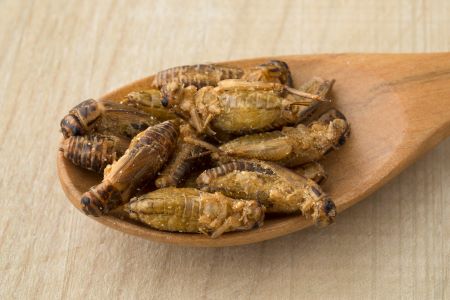Livestock's new look

Care to munch on a few tasty Chili-Lime Crickets? How about some crunchy Coconut Brittle Bugitos made from mealworms?
Those are two of the insect snacks sold by San Francisco-based company Don Bugito, whose founder and owner, Maria Martinez, brought samples to taste at a panel session at Alberta Innovates’ Inventures event in Calgary.
According to her and other panelists, the insect agriculture industry has moved beyond being a curious novelty and is poised to take off in North America, and globally.
“We’ve been eating insects for 700 years,” said Martinez, whose company’s products are inspired by pre-Columbian Mexican cuisine.
People at first thought it was a joke when Don Bugito started selling edible insects in 2010, she said. Since then, “our business has grown organically by 10 percent every year.”
“There are a billion people in the world that rely on insects as their primary source of protein,” said Keith Driver, executive vice-president, North America, for Protix Biosystems BV, headquartered in the Netherlands.
Protix operates the world’s largest, most advanced 150,000-square-foot insect farm facility in the Netherlands. Driver said the company may build a second, 180,000-sq-ft facility capable of producing more than 60,000 tonnes per year of insect protein.
According to Protix, insects can turn low-grade food waste into valuable high-end proteins and fats, and can help create a circular food system enabling a shift from a resource-depleting linear system of production reliant on plant crops and livestock.
Protix uses black soldier fly larvae to create its insect proteins and fats that are supplied to the human food, aquaculture, animal feed, agriculture and pet food industries.
Driver said the animal feed market will be the gateway to expanding the market for insect-based foods for people. Pet food is a $30-billion-a-year market in North America.
“The demand for these [insect] proteins in the pet food space is almost overwhelming. We already have approval for many of our products in North America,” said Aaron Hobbs, executive director of the North American Coalition for Insect Agriculture, a U.S.-based trade association that works with the insect agriculture industry across Mexico, the U.S. and Canada.
The edible insect market, which surpassed $112 million in 2019, is projected to grow at a compound annual growth rate of more than 47 percent, reaching $1.5 billion by 2026, according to a forecast by Global Market Insights Inc.
Canada's insect farming industry expanding
In Canada, Enterra Food Corp., based in Langley, B.C., operates a 17,500-sq-foot facility that feeds food waste to black soldier flies to produce high-protein food for chickens, fish, and pets, along with organic fertilizer.
In 2021, Enterra Food received $6 million in federal funding to build a new 170,000-sq-ft plant just north of Calgary, and also plans to eventually build another plant in either Ontario or Quebec.
Beyond animal feed, insect agriculture also is being used to produce quickly and sustainably other products and ingredients.
Future Fields, a biotech company in Edmonton, farms common fruit flies that the company uses to manufacture recombinant proteins for biopharmaceutical research, biotherapeutics, and cultivated food applications. The company’s technology eliminates the need for large and expensive stainless steel bioreactors. This February, Future Fields announced a US$11.2-million investment from VC firms and government contracts.
Entomo Farms in Norwood, Ontario, produces cricket powders, cricket flour mealworm powders and whole roasted crickets in its 60,000-sq-foot facility.
Aspire Food Group of London, Ontario, and its partners (which include TELUS Agriculture) received $16.8 million in 2021 from the Next Generation Manufacturing Canada innovation cluster to help fund the world’s first fully automated cricket protein manufacturing facility, a 150,000-sq-ft plant capable of producing 12,000 tonnes of crickets annually.
Last year, Agriculture and Agri-Food Canada invested up to $8.5 million to support the Aspire facility, which is on track to ramp up to at least 50 per cent of production this year and full production in the first half of 2024.
Altrene, an insect farming company in Kemptville near Ottawa, hydraulically compresses the fatty acids out of insects and uses them to make a skin care product line called Insekt that includes a face cleanser, face moisturizer and a face oil.
“We’re seeing a proper ecosystem develop where there are going to be lots of opportunities” in primary production and specialty products, Driver told Inventures.
“The insects can also be using the one-third of food that gets produced and wasted. That can be recycled back into protein,” said panelist Dr. Christine Picard, PhD, associate professor of biology and co-director of the Center for Environmental Sustainability through Insect Farming, a research centre at Indiana University-Purdue University in Indianapolis.
The centre, partnered with two other U.S. universities and the industry, was established in 2021 through a $2.2-million grant from the U.S. National Science Foundation.
“Any of these insects, at some point are going to be broken down into their individual components and used for various purposes,” including potentially biofuels and bioplastics, Picard said.
Insect farming’s environmental performance
A wide range of edible insect species, with their high contents of protein, fat, minerals, vitamins and fibre, can play a significant role in addressing food insecurity as insect farming may offer a sustainable means of food production, according to a 2021 study by researchers in Germany. “Compared to cattle raising, insects emit relatively few greenhouse gases and little ammonia and require significantly less land and water,” said the study.
However, insect farming companies need to conduct life cycle assessments (LCAs) to evaluate the environmental performance of their production process and products, according to a 2022 study by an Italian research team that examined more than 20 LCAs conducted during the last decade.
Along with the energy used in heating and cooling insect farming facilities, “It is evident that the influence of several factors, such as insect diet quality and other breeding conditions, on GHG emissions, especially nitrous oxide, remains unclear and needs to be thoroughly investigated,” said the study.
According to the study, given the lack of published LCA studies about the environmental impacts of insect farming operations, another thing needed is a comparison of the environmental sustainability assessment of insect products with other conventional food products, such as meat.
As for the environmental footprint of Protix’s insect farming operation, a 2022 LCA study, conducted by the German Institute of Food Technologies, showed the greenhouse gas (CO2 equivalent) footprint of Protix’s insect meal was nearly seven-fold lower than that of the soy protein concentrate commonly used in livestock and fish feed. The company’s insect meal production also used about 64 percent per cent less water than needed for the soy product.
But are North American consumers ready to accept insects as food for people? Insect snack entrepreneur Martinez’s response is: Hardly anybody in North America ate raw fish 50 years ago, and now sushi is eaten and enjoyed everywhere.
R$
Events For Leaders in
Science, Tech, Innovation, and Policy
Discuss and learn from those in the know at our virtual and in-person events.
See Upcoming Events
You have 0 free articles remaining.
Don't miss out - start your free trial today.
Start your FREE trial Already a member? Log in
By using this website, you agree to our use of cookies. We use cookies to provide you with a great experience and to help our website run effectively in accordance with our Privacy Policy and Terms of Service.





